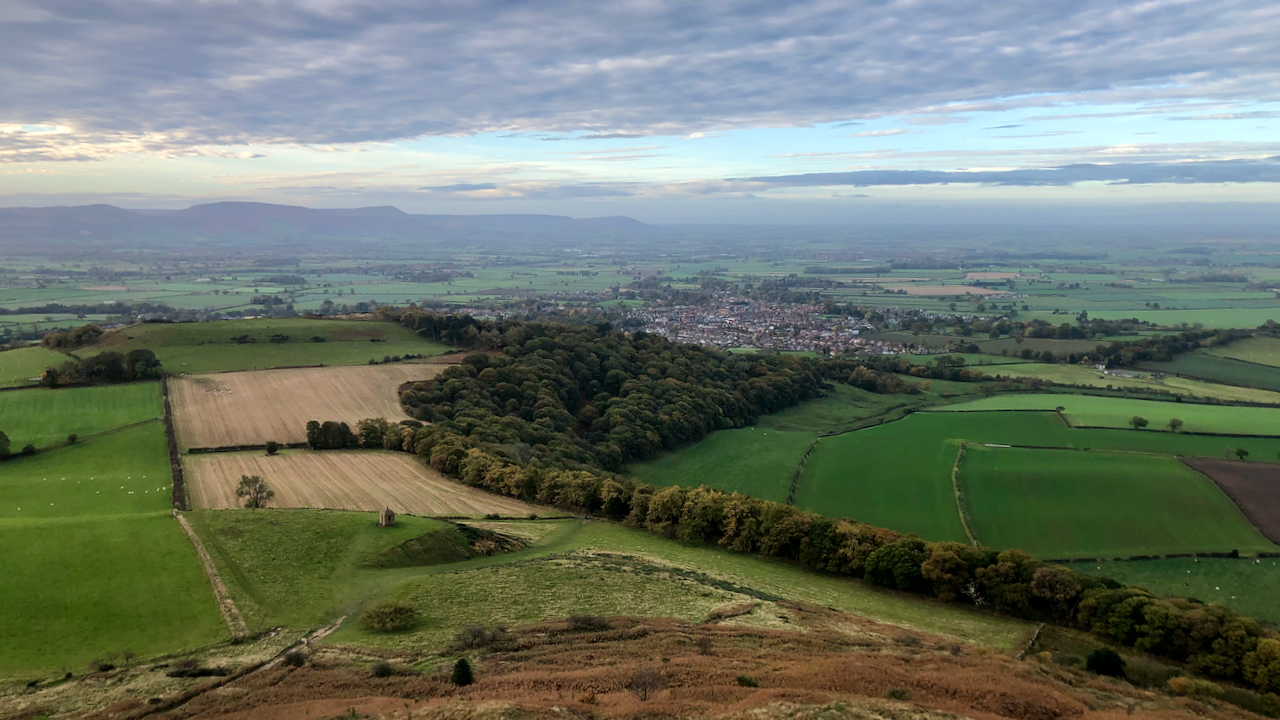We are told that, as a species, our activities emit 34 gigatonnes of CO² per year which would need around 68 million square kilometres of forest to ‘sequestrate’ — this is about half the planet’s land area, so a bit unrealistic1Carbonindependent.org. (2021). Planting trees is not the answer. [online] Available at: https://www.carbonindependent.org/76.html [Accessed 8 Nov. 2021]..
These numbers are vast. Gigatonnes. I can no more visualise a gigatonne than I can a billion miles or a million years.
So, as I ran around ‘my patch’ this morning, I started to wonder how much carbon, Newton Wood is storing and sequestrating.
From the top of Roseberry Topping, I could see almost the full sweep of the mature oak woodland of Newton Wood. Cliff Ridge Wood, on the far side of Cliff Rigg was out of sight, but added together they make a total of just over 45 hectares. The rest of the National Trust’s Roseberry property comprises 92 hectares of semi-open heathland, largely bracken infested.
Woodland stores carbon, in the trees themselves, their trunks, leaves and roots, and in the soil. Amounts vary with the overall mix of vegetation, the soil type and structure (microbes), and the climate. In general, there is 3 to 8 times more carbon stored in the soil than in the vegetation2Habitats and carbon, storage and sequestration Penny Anderson, CEcol, FCIEEM, (retired) Penny Anderson Associates. (n.d.). [online] Available at: https://cieem.net/wp-content/uploads/2020/08/Habitats-and-Carbon-Storage-and-Sequestration-Penny-Anderson.pdf..
With so many variables, it is difficult to arrive at a precise figure for Newton Woods but, for want of a better guess, I’ll use a figure of 149 tonnes per hectare3Carbon Brief. (2018). Planting a mix of tree species “could double” forest carbon storage – Carbon Brief. [online] Available at: https://www.carbonbrief.org/planting-a-mix-of-tree-species-could-double-forest-carbon-storage [Accessed 8 Nov. 2021]..
Which means our 45 hectare Newton Wood is storing 6,705 tonnes of carbon.
That’s all very well, that carbon is sitting there and will eventually be released into the atmosphere in accordance with the natural carbon cycle when the trees die and decay.
Perhaps the more important metric is the amount of carbon that can be sequestrated or captured from the atmosphere. The usual measure is by tonnes of CO² — 1 Tonne of C is equivalent to 3.67 tonnes of CO².
Again, the variables are many, but one Canadian website suggests an acre of mature trees can capture 2.6 tonnes of CO² per year4Treesintrust.com. (2012). Trees In Trust – Environmental Info. [online] Available at: http://www.treesintrust.com/environmental.shtm [Accessed 8 Nov. 2021].. So on this basis, Newton Wood captures annually 289 tonnes of CO²52.6 tonnes/acres x 2.471 acres/ha x 45 ha.
The UK’s average CO² emissions per person is 5.4 tonnes6Worldbank.org. (2020). CO2 emissions (metric tons per capita) | Data. [online] Available at: https://data.worldbank.org/indicator/EN.ATM.CO2E.PC [Accessed 8 Nov. 2021].. So Newton Wood is capturing the annual emissions of around 54 of us. That’s my road sorted out then.
To put it another way, William Shatner’s trip to the edge of space a few months ago would have exhausted up to 300 tons of CO² into the upper atmosphere7Gammon, K. (2021). How the billionaire space race could be one giant leap for pollution. [online] the Guardian. Available at: https://www.theguardian.com/science/2021/jul/19/billionaires-space-tourism-environment-emissions [Accessed 8 Nov. 2021]. Newton Wood would not be big enough to cope with the emissions from his flight of eleven minutes.
- 1Carbonindependent.org. (2021). Planting trees is not the answer. [online] Available at: https://www.carbonindependent.org/76.html [Accessed 8 Nov. 2021].
- 2Habitats and carbon, storage and sequestration Penny Anderson, CEcol, FCIEEM, (retired) Penny Anderson Associates. (n.d.). [online] Available at: https://cieem.net/wp-content/uploads/2020/08/Habitats-and-Carbon-Storage-and-Sequestration-Penny-Anderson.pdf.
- 3Carbon Brief. (2018). Planting a mix of tree species “could double” forest carbon storage – Carbon Brief. [online] Available at: https://www.carbonbrief.org/planting-a-mix-of-tree-species-could-double-forest-carbon-storage [Accessed 8 Nov. 2021].
- 4Treesintrust.com. (2012). Trees In Trust – Environmental Info. [online] Available at: http://www.treesintrust.com/environmental.shtm [Accessed 8 Nov. 2021].
- 52.6 tonnes/acres x 2.471 acres/ha x 45 ha
- 6Worldbank.org. (2020). CO2 emissions (metric tons per capita) | Data. [online] Available at: https://data.worldbank.org/indicator/EN.ATM.CO2E.PC [Accessed 8 Nov. 2021].
- 7Gammon, K. (2021). How the billionaire space race could be one giant leap for pollution. [online] the Guardian. Available at: https://www.theguardian.com/science/2021/jul/19/billionaires-space-tourism-environment-emissions [Accessed 8 Nov. 2021].

Leave a Reply